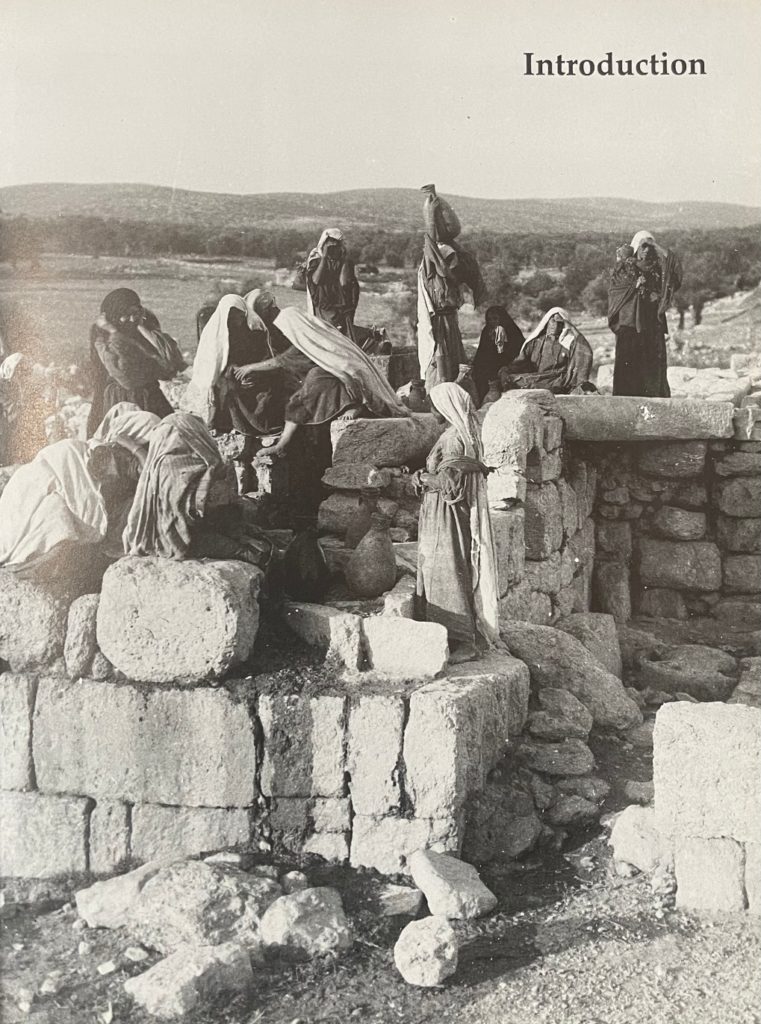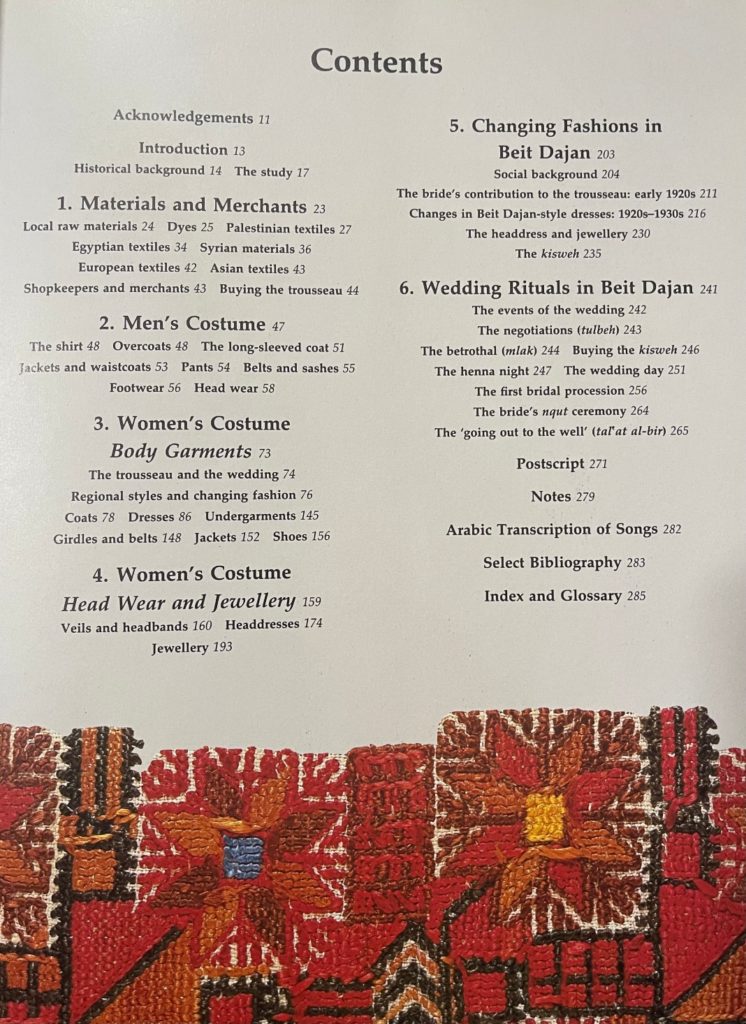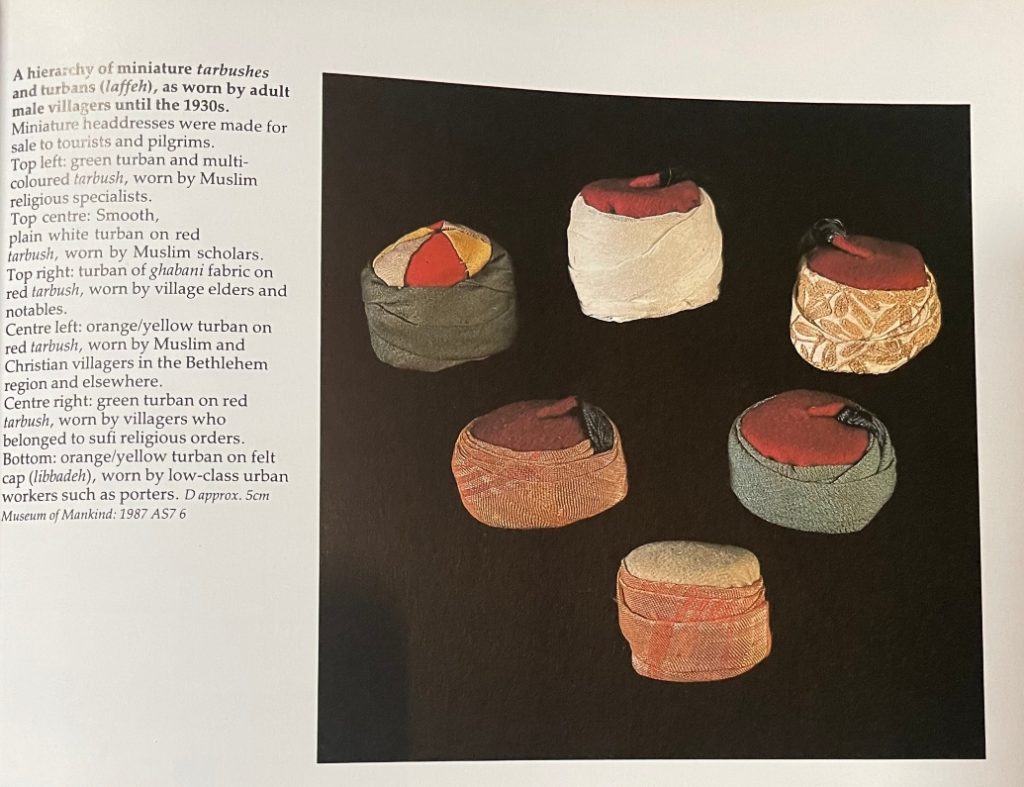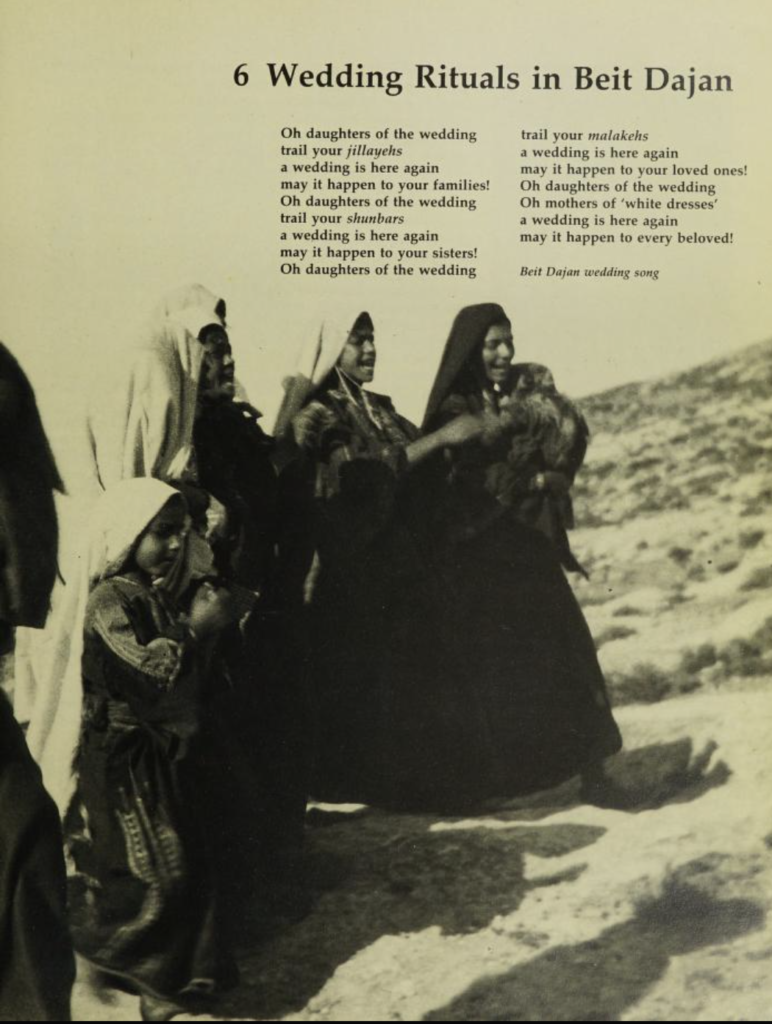Title: Palestinian Costume
Author: Shelagh WeirPhotographer: VariousPublisher: British Museum Publications Publishing year:
1989 About The Author
Shelagh Weir was a curator of Middle East at the former Museum of Mankind in the British Museum. She is an authority on traditional Palestinian dress, having written multiple books on garments, textiles and embroidery. Shelagh is also a prominent scholar of Yemeni costumes and culture. Also by Shelagh Weir:
- Embroidery from Palestine, 2006
- Palestinian Embroidery: Cross-stitch Patterns from the Traditional Costumes of the Village Women of Palestine, 1988
- Spinning and weaving in Palestine
Format & Layout
- Hardcover
- 288 pages
- ISBN 10: 0714115975
- English
In this book, Weir documents
Palestinian costumes from the nineteenth century onwards with a focus on the thirty-year period from the end of World War I to 1948. The 1920s and 1930s marked relative economic improvement, resulting in more extensive and lavishly embroidered costume collections. The book describes the main regional styles such as the
thawb
Thawb: (Arabic: thawb, Pl. Athwāb/thībān), can be pronounced thobe
Thobe: (Arabic: thawb, Pl. Athwāb/thībān), can be pronounced thawb or tobe
Tobe: (Arabic: thawb, Pl. Athwāb/thībān), can be pronounced thawb or thobe based on locale. The standard Arabic word for ‘fabric’ or ‘garment’. It can refer to a qamīs-like tunic worn by men and women in the Arabian Peninsula, Iraq, the southern and south-western ports and islands of Iran, and some countries in East and West Africa. More specifically, it can refer to the square-shaped Bedouin overgarment worn by women. based on locale. The standard Arabic word for ‘fabric’ or ‘garment’. It can also refer to a qamīs-like tunic worn by men and women in the Arabian Peninsula, Iraq, the southern and south-western ports and islands of Iran, and some countries in East and West Africa. More specifically, it can refer to the square-shaped Bedouin overgarment worn by women. or tobe
Tobe: (Arabic: thawb, Pl. Athwāb/thībān), can be pronounced thawb or thobe based on locale. The standard Arabic word for ‘fabric’ or ‘garment’. It can refer to a qamīs-like tunic worn by men and women in the Arabian Peninsula, Iraq, the southern and south-western ports and islands of Iran, and some countries in East and West Africa. More specifically, it can refer to the square-shaped Bedouin overgarment worn by women. based on locale. The standard Arabic word for ‘fabric’ or ‘garment’. It can also refer to a qamīs-like tunic worn by men and women in the Arabian Peninsula, Iraq, the southern and south-western ports and islands of Iran, and some countries in East and West Africa. More specifically, it can refer to the square-shaped Bedouin overgarment worn by women in the Arabian Gulf region. and the
qumbaz
Qumbāz: (Arabic; Synonyms: sayah
Ṣāyah: (Classical Persian: sāya – shadow; Synonyms: zubūn, qumbāz, gombaz, yalak
Yalak: (Ottoman Turkic: yelek
Yelek: (Old Anatolian: yélek – Vest; Synonyms: Jelick, Jilek), short waist or hip length vest traditionally worn by both Ottoman men and women throughout the empire. Ranging from sleeveless to full sleeves, these vests were usually front open and without any fastenings. Often cepken jackets were used as yelek. – a hip or waist length vest; from Old Anatolian: yélek – Vest), a short-sleeved waistcoat traditionally worn by men and a long outer robe or tight jacket either sleeveless or short sleeved with a tight bodice traditionally worn by women in the Ottoman controlled Levant.
), long front open, unlined, lightweight silk traditional cloak with quarter or no sleeves fastened at the waist often worn by men and women in the Levant, Fertile Crescent, and Najd regions.
, zubūn, gombaz, yalak
Yalak: (Ottoman Turkic: yelek
Yelek: (Old Anatolian: yélek – Vest; Synonyms: Jelick, Jilek), short waist or hip length vest traditionally worn by both Ottoman men and women throughout the empire. Ranging from sleeveless to full sleeves, these vests were usually front open and without any fastenings. Often cepken jackets were used as yelek. – a hip or waist length vest; from Old Anatolian: yélek – Vest), a short-sleeved waistcoat traditionally worn by men and a long outer robe or tight jacket either sleeveless or short sleeved with a tight bodice traditionally worn by women in the Ottoman controlled Levant.
), also pronounced ‘umbaz or ‘imbaz is a long front open, unlined, lightweight silk traditional cloak either with quarter or no sleeves fastened at the waist often worn by both men and women in the Levant, Fertile Crescent, and Najd regions.
and explains how colours and styles indicated whether a woman was from a village, town, or a nomadic Bedouin. We also get to learn about the materials used and the forms of embroidery and adornment based on two decades of research that the author started back in 1967.

Photos, Illustrations & Diagrams
This book features studio photographs of garments and articles of dress, archive photographs of Palestinian people and villages from the nineteenth and early twentieth centuries, and photographs of clothes that were still made and worn at the time of publication.
The large assortment of images makes this book a window into the heritage and everyday life in Palestine over the past century.  The large assortment of images makes this book a window into the heritage and everyday life of Palestine over the past century.
The large assortment of images makes this book a window into the heritage and everyday life of Palestine over the past century. Structure

This book comprises six chapters, a postscript, notes, Arabic song transcripts, a bibliography, and a glossary. Following the introduction, the book starts with the materials commonly used to create clothes and their sources. These materials included cotton imported from Egypt, indigo
Indigo: (Latin: Indigo – India, synonym: nil
Nīl: (Latin: indigo), Arabised term for Indigo, a natural dye belonging to the ‘Indigofera Tinctoria’ species of plants that have been cultivated in East Asia, Egypt, India, and Peru since antiquity. According to Pliny the Elder, it was named after India as it was the source of the dye.), a natural dye belonging to the ‘Indigofera Tinctoria’ species of plants that has been cultivated in East Asia, Egypt, India, and Peru since antiquity. According to Pliny the Elder, it was named after India as it was the source of the dye. produced in the Beisan area, and luxurious silks and gold and silver threads imported from Syria. This particular chapter also outlines merchants, trade, and the main centers where villagers bought their clothes. Weir goes on to examine and analyse costumes by gender, looking at articles of dress worn by men in chapter 2 and women in chapter 3 followed by headwear and jewellery in chapter 4. Weir paid special attention to the village of Beit Dajan which had beautiful costumes and had been a leader of fashion in the Jaffa region. She dedicates the last two chapters to the history of the village, and the wedding traditions of its people. Content Highlights
Reading this book, you can see the effort the author has put into contextualising the costumes by including the historical background and evolution of clothing over time. And while most research tends to delve into women’s articles of dress rather than men’s, Weir dedicates a full chapter to men’s costume and provides a comprehensive view of what Palestinian men traditionally wore, detailing the intricate artisanship involved in producing the unique jackets, hats and even footwear among other articles of dress.  The book also delves into wedding traditions. It walks us through the process of acquiring the trousseau including the kisweh that a groom would present to his bride at the time of their marriage and the Jihaz which the bride and her mother would make themselves in the months (and sometimes years) leading up to the wedding.
The book also delves into wedding traditions. It walks us through the process of acquiring the trousseau including the kisweh that a groom would present to his bride at the time of their marriage and the Jihaz which the bride and her mother would make themselves in the months (and sometimes years) leading up to the wedding.  Palestinian Costume is a testament to the importance of preserving costumes and embracing their beauty. This is a notion that is shared at The Zay
Zay: (Arabic: costume, Pl. azyaā’), a set of clothes in a style typical of a particular country or historical period. Initiative, as we work towards expanding our collection and the stories the pieces encompass, from across the Middle East. Traditional songs are weaved in throughout the book, in doing this, Weir paints a picture of life in these towns over the centuries and the celebrations of their inhabitants and their sense of community. Not only does this context bring these people and their stories to life, but it also makes for a great read.
Palestinian Costume is a testament to the importance of preserving costumes and embracing their beauty. This is a notion that is shared at The Zay
Zay: (Arabic: costume, Pl. azyaā’), a set of clothes in a style typical of a particular country or historical period. Initiative, as we work towards expanding our collection and the stories the pieces encompass, from across the Middle East. Traditional songs are weaved in throughout the book, in doing this, Weir paints a picture of life in these towns over the centuries and the celebrations of their inhabitants and their sense of community. Not only does this context bring these people and their stories to life, but it also makes for a great read. Conclusion
This book is a fascinating time capsule into different aspects of life, traditions, and cross-cultural communication between Palestine and other parts of the Levant and the Arab World. Because Weir started her research in the 1960s, she managed to document many first-hand accounts from people that lived during the British mandate period, prior to the establishment of the State of Israel in 1948 and the displacement of the Palestinian peoples. Since then, many of these villages have been depopulated, and the families that once lived there and their traditions and festivities are long gone, but thanks to Weir’s meticulous research and efforts, we get to know some of their names, some of their stories, some of what they valued most, and some of what they once wore. Weir has helped preserve and honour a priceless piece of our shared human history. You can read this book for free HERE or buy the rather fabulous coffee table version.
You can view Palestinian articles of dress on our Digital Archive
HERE 








